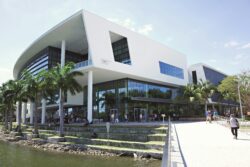Florida Med Schools: Your 2025 Strategy Guide
June 11, 2025 :: JD Deal
The Florida 11 – Who They Are, What They Offer, and Why It Matters
Let’s get something straight: Florida isn’t one-dimensional when it comes to medical education. It’s not just beaches and palm trees and that one school in Gainesville everyone knows about. Florida’s med school scene is wild in the best way—think elite public flagships with billion-dollar research budgets, nimble young schools rewriting the curriculum playbook, and DO programs quietly outpacing expectations with sky-high match rates.
This isn’t a top-3-or-bust state. It’s a choose-your-own-adventure. And if you’re strategic, Florida gives you serious angles to play. Want to dive headfirst into a translational neuroscience lab? Covered. Looking for mission-driven primary care training embedded in underserved communities? Absolutely. Hoping to stack a few degrees while dodging six-figure debt? There’s a school for that, too.
But not all programs here are created equal—and they’re definitely not copy-paste versions of each other. Each one has a pulse, a personality, a particular “type” it attracts. This next section isn’t just going to tell you who they are. It’s going to show you what makes each school tick: what they offer, where they shine, what you should watch out for, and who’s going to thrive once they’re in.
The Florida 11, decoded. Let’s go.
University of Florida College of Medicine (Gainesville)
If the University of Florida College of Medicine were a person, it’d be the brainy, community-focused overachiever who shows up to your group project with both the literature review and snacks for the team. It’s got the résumé: NIH powerhouse, robust research infrastructure, a sprawling academic health center. But what makes UF Med interesting isn’t just the prestige—it’s the purpose. This place draws students who are obsessed with impact. You’ll find them scrubbing into surgery at Shands one day, and the next they’re out in underserved parts of Florida delivering real-world care. There’s a quiet confidence here. You don’t come to UF to peacock. You come to put in the work, get your hands dirty, and build the kind of career that blends lab results with patient results. If you’re looking for a school that threads academic rigor with deep service ethos—without screaming about it—this is your spot.
| 3.92 | 515–516 | ~6.8% | 135/year | $37,130 / $49,390 |
| Avg. GPA | Avg. MCAT | Interview Rate | Class Size | Tuition & Fees (IS / OOS) |
| 3.92 | 515–516 | ~6.8% | 135/year | $37,130 / $49,390 |
What Sets It Apart: A true research titan with elite NIH funding, a massive hospital system, and room for academic deep dives—yet still manages to anchor students in real-world medicine through rural rotations and free clinics. Strong MD-PhD and dual-degree options seal the deal.
Vibe Check: Driven, collaborative, mission-minded. Students are ambitious, yes, but also deeply involved in local community health efforts. It’s a “grind with purpose” kind of culture.
Trade-offs: Gainesville is no cultural capital. It’s very “college town”—safe, compact, a bit sleepy. If you’re craving big-city energy or a high-end clinical variety out the gate, this may feel limiting.
Who Should Consider It: Florida residents with serious research chops and a 515+ MCAT who want the best of both worlds: academic prestige and real, meaningful patient engagement. Also a killer value for in-state students with long-term ties to Florida medicine.
USF Health Morsani College of Medicine (Tampa)
USF Morsani feels like the future: crisp, modern, quietly elite. It’s the kind of school that doesn’t scream for attention because it knows exactly what it’s building—something big, something smart, something sustainable. Its students tend to be low-key killers: 95th-percentile MCATs, grounded personalities, mission-driven mindsets. What makes this place click isn’t just its sparkling new facilities or rapidly expanding research—it’s the culture of competence without the ego. Morsani is for applicants who want serious medicine without a prestige cult. There’s room here to pursue high-level science, get hands-on with community care, and still be home in time for dinner. If you’re looking for a school that values both academic firepower and human connection, and does it all in a city that’s growing as fast as your ambition, Morsani’s a strong contender.
| Avg. GPA | Avg. MCAT | Interview Rate | Class Size | Tuition & Fees (IS / OOS) |
| 3.95 | 520 | N/A | 130/year | ~$33,000 / ~$49,000–$55,000 |
What Sets It Apart: Cutting-edge facilities and a rapidly rising research profile, especially in public health and neuroscience. For a school this selective, it flies surprisingly low under the national radar. Feels like you’re getting in early on a future powerhouse.
Vibe Check: Ambitious but not arrogant. Students are high-achieving but grounded—more team players than gunner prototypes. Expect strong mentorship, solid peer support, and a quietly competitive edge.
Trade-offs: Tampa isn’t cheap anymore. And while Morsani’s making waves regionally, the national prestige still lags behind its stats. It’s not “household name” territory just yet.
Who Should Consider It: Applicants with a strong academic profile who want elite numbers without the coastal chaos. Ideal for those seeking a rising star in med ed that offers serious research access and a community-first ethos. Florida residents especially will get huge ROI.
University of Miami Miller School of Medicine (Miami)
Miami’s Miller School is the dazzling international jet-setter of Florida med schools—think global health, top-tier research, cutting-edge biotech, and VIP internships at Baptist or Jackson Memorial. It’s where sun, swagger, and serious science collide. Students here are bold, network-savvy, and comfortable navigating both patent law and patient care in English, Spanish, or Creole. If you want cosmopolitan clinical exposure and research pedigree—with a dash of Latin flair—Miller brings.
| Avg. GPA | Avg. MCAT | Interview Rate | Class Size | Tuition & Fees (IS / OOS) |
| ~3.85 | ~512 | ~4–5% | 200/year | ~$43,000 / ~$60,000+ |
What Sets It Apart: Global health pipelines, transplant surgery strengths, Miami’s UHealth research enterprise, and sky-high clinical volume at Jackson Memorial—more than enough to build a CV.
Vibe Check: Fast-paced, prestige-aware, and opportunistic—but not shallow. Students move in international circles, but many are driven by local, underserved work too.
Trade-offs: Sky-high tuition and the hustle of South Florida. Competition is intense, and cost of living reflects that Miami energy.
Who Should Consider It: Cutting-edge research fans, multilingual communicators, global-health dreamers, and those who thrive in a vibrant, diverse city.
UCF College of Medicine (Orlando)
UCF Med is the fresh, energetic disruptor in Orlando. It’s scrappy, practical, and mission-driven, founded to meet central Florida’s growing healthcare needs. Students here juggle Morsani-level academic standards with a collaborative “we’re doing this together” startup vibe. From simulation labs to county clinics, UCF’s all about digging in and solving problems—no mess, no fluff.
| Avg. GPA | Avg. MCAT | Interview Rate | Class Size | Tuition & Fees (IS / OOS) |
| ~3.80 | ~510 | ~6% | 175/year | ~$35,000 / ~$55,000 |
What Sets It Apart: Hands-on med ed, homegrown hospital partnerships, and a tech-forward curriculum that’s less lectern, more simulation.
Vibe Check: Collegial, focused, with a “get it done” ethic. It’s med ed with real-world roots—helping Orlando build its own healthcare muscle.
Trade-offs: Less name recognition nationally. Orlando isn’t NYC or LA, and the campus vibe can feel a bit corporate.
Who Should Consider It: Applicants rooted in Central Florida, eager to shape a growing med program, or focused on community-focused primary care with modern training tools.
FAU Schmidt College of Medicine (Boca Raton)
FAU Schmidt is the stealth innovators’ pick: new(ish), high-tech, and community-grounded. It’s centered around service, perfect for students motivated by diversity and outreach—plus, Boca Raton’s tranquil living makes all-nighters feel… nicer.
| Avg. GPA | Avg. MCAT | Interview Rate | Class Size | Tuition & Fees (IS / OOS) |
| ~3.75 | ~510 | ~8% | ~55/year | ~$29,000 / ~$49,000 |
What Sets It Apart: Tight-knit cohort, community-centered primary care model, and an innovation mindset baked into its curriculum.
Vibe Check: Friendly, supportive, with a relaxed beach-town temperament—but there’s serious purpose beneath.
Trade-offs: Smallest class size. Clinical rotations depend heavily on regional systems—not big academic hospitals.
Who Should Consider It: Team players who are drawn to service in Sun Belt communities and those craving modern curriculum in a chill yet driven environment.
FIU Herbert Wertheim College of Medicine (Miami)
FIU Wertheim is Miami’s mission school: sleek, socially committed, and focused on addressing health inequities in its backyard. A STEM powerhouse with strong public health roots and immersive clinical experiences from day one, it’s made for student-doctors who want both brains and benevolence.
| Avg. GPA | Avg. MCAT | Interview Rate | Class Size | Tuition & Fees (IS / OOS) |
| ~3.80 | ~512 | ~7% | ~60/year | ~$28,000 / ~$48,000 |
What Sets It Apart: Social mission in action—community immersion, bilingual advocacy, and strong public health curriculum baked into every year.
Vibe Check: Purpose-driven, culturally fluent, team-focused. Students here are on a mission, and workshops, not lectures, are their currency.
Trade-offs: Rotations at regional hospitals are rich, but high-tier research opportunities are still scaling.
Who Should Consider It: Applicants passionate about community medicine, Miami natives looking to give back, and team builders more than legacy seekers.
FSU College of Medicine (Tallahassee)
FSU Med is the premed’s reset button—it welcomes reinvention, devotion to rural care, and educates with a focus on underserved, often forgotten regions. It’s the place where long-game thinkers who value patient continuity and systemic health in the Panhandle thrive.
| Avg. GPA | Avg. MCAT | Interview Rate | Class Size | Tuition & Fees (IS / OOS) |
| ~3.81 | ~512 | ~9% | ~120/year | ~$29,000 / ~$49,000 |
What Sets It Apart: A pipeline for rural medicine leaders, outstanding rural clinical training, and strong state-based mission.
Vibe Check: Mission-first, close-knit, no-frills. Folks are here to build rural healthcare solutions—not network or headline chase.
Trade-offs: Rural focus limits elite hospital exposure. Tallahassee’s smaller urban scene isn’t energizing for everyone.
Who Should Consider It: Applicants committed to rural/underserved populations, looking to lead community health, live in small towns, and practice continuity medicine.
Nova Southeastern University Dr. Kiran C. Patel College of Allopathic Medicine (Davie)
Nova Patel is the polished, purpose-built med school for polished pragmatists: innovative curriculum, community partnerships, and Orlando–Miami access without the overload. Its grads are known for top-tier residency matches and blended practice-ready skills.
| Avg. GPA | Avg. MCAT | Interview Rate | Class Size | Tuition & Fees (IS / OOS) |
| ~3.80 | ~512 | ~10% | ~575 total | ~$55,000 (private) |
What Sets It Apart: Immersive curriculum, robust residency placement, private-school pedigree with vibes of innovation and real-world prep.
Vibe Check: Big—and bustling—with resources, networking, and a business-smart mindset, offering flexibility and hustle.
Trade-offs: Private-school price tag. Large cohorts can dilute close mentorship early on.
Who Should Consider It: Applicants who want strong match outcomes, practical training, and flexibility—or those aiming for high-match prestige outside the public system.
LECOM Bradenton (DO)
LECOM Bradenton is here to challenge expectations—an osteopathic school that proves DO = high-match success. It’s laid-back yet rigorous, and tailored for learners who value a holistic, patient-centered care model.
| Avg. GPA | Avg. MCAT | Interview Rate | Class Size | Tuition & Fees (IS / OOS) |
| ~3.54 | ~502 | ~15% | ~325 total | ~$44,000 (private) |
What Sets It Apart: Exceptional DO program with integrated family med, strong match record, and emphasis on hands-on training.
Vibe Check: Welcoming, holistic, community-minded. Students support each other even through pressure-testing OMM labs.
Trade-offs: Less national name recognition vs MD schools. DO focus means different trajectory and residency.
Who Should Consider It: Solid-fit for holistic-medicine fans, Florida DO-route seekers, and students aiming for primary care or family med pathways.
Nova Southeastern University Dr. Pallavi Patel College of Osteopathic Medicine (Fort Lauderdale)
Patel DO is Nova’s sister school focused on equitable care and social impact. It produces wellness-minded physicians who thrive in community settings—it’s the antidote to hospital hustle, without sacrifice of skill.
| Avg. GPA | Avg. MCAT | Interview Rate | Class Size | Tuition & Fees (IS / OOS) |
| ~3.60 | ~503 | ~18% | ~315 total | ~$48,000 (private) |
What Sets It Apart: A social-enterprise ethos with emphasis on primary care, health equity, and community leadership.
Vibe Check: Empathetic, mission-rooted, and hands-on. Cohort feels collaborative and values-driven.
Trade-offs: Similar private costs. Steering quickly into DO residencies with potential specialization trade-offs.
Who Should Consider It: Ideal for students pursuing DO pathway, public service, and health equity in South Florida—particularly those drawn to mentorship and mission over prestige.
Burrell College of Osteopathic Medicine (Melbourne)
Burrell is a social mission engine in Brevard County: a lean DO school with a dual focus on rural/urban primary care pipelines and real community impact. It’s quietly building a reputation as a match machine.
| Avg. GPA | Avg. MCAT | Interview Rate | Class Size | Tuition & Fees (IS / OOS) |
| ~3.55 | ~502 | ~12% | ~165/year | ~$54,000 (private) |
What Sets It Apart: Rural and urban reach, focus on primary care, and strong career placements in Florida communities.
Vibe Check: Down-to-earth, service-driven, and tightly knit. Students are there to serve and stay.
Trade-offs: Fewer research opportunities, less national spotlight, private-school cost.
Who Should Consider It: Florida residents committed to primary care and rural health—especially those wanting to serve underserved communities with the DO advantage.
Strategy Beyond the Stats – How to Actually Choose Between These Schools
You’ve seen the GPAs. You’ve clocked the MCATs. You’ve skimmed the tuition rows and maybe even Googled how far Davie is from civilization. But now comes the real question: How do you actually choose?
This isn’t about finding “the best school.” That’s a myth. It’s about finding the best fit—the program that aligns with your goals, your style, your finances, and yes, your odds. Let’s break down the four dimensions that actually matter.
Cost vs. Prestige
First, that tuition column? Don’t gloss over it. The difference between $28K and $58K a year over four years is not imaginary. It’s six figures of real money—before interest. The question is: what are you buying for that price tag?
If you’re deciding between, say, a high-cost, mid-tier private school out-of-state and an affordable in-state MD program with solid match rates? The prestige premium better be worth it. And spoiler alert: unless it’s Harvard or Stanford, it probably isn’t. Residency directors care more about your Step scores, your letters, and your performance in rotations than whether your med school hosted the Nobel Prize dinner.
Bottom line: prestige is nice, but return on investment is smarter.
In-State vs. Out-of-State Odds
Florida plays favorites. Most public med schools here protect spots for their own—some with 60–80% of their class pulled from in-state. If you’re a Florida resident, this is your cheat code. You’re not just competing for fewer seats; you’re working with a legit admissions advantage. Don’t waste it.
If you’re OOS and aiming for schools like UF or FSU? Know that you’re walking into a tilted field. That doesn’t mean you can’t make a compelling case—but you’ll need to bring something special.
Mission Fit
Every school has a personality—and a purpose. FSU is building a physician army for underserved and rural communities. FAU and FIU are rooted in South Florida’s multilingual, multicultural frontline care. UMiami? They’re looking for translational researchers, global thinkers, academic scalers.
This isn’t just branding—it’s how they build their classes. If your app reads like a mismatch, no stat will save you. Read between the lines. Ask yourself: what kind of doctor does this school want to graduate? If that’s not you, keep it moving.
Curriculum and Clinicals
Some schools throw you into patient care week one. Others wait till the white coat starts to yellow. Some teach in systems, some in blocks. Some partner with massive academic hospitals. Others rely on regional clinics.
These differences matter. If you learn best by doing, you’ll suffer in lecture-heavy environments. If you’re research-driven, schools with early clinicals but limited lab access may leave you frustrated. Look at where you’ll rotate, when, and with whom. That’s your real training.
Smart applicants know: this isn’t about where you can get in. It’s about where you’ll thrive. The stats get you to the table. Fit determines what happens next. Choose like someone who’s going to be a doctor, not just someone who wants to be one.
Conclusion – What “Fit” Really Means
Let’s rewire the default question. It’s not “what’s the best med school?” It’s “what’s the best med school for me?”
Florida might not have been on your radar. But maybe it should be. This state isn’t offering a one-size-fits-all med school model—it’s serving a full spectrum: research behemoths, community-care hubs, urban energy, rural grounding, MD, DO, public, private. Whether you’re looking to double down on neuroscience in a major hospital or become a bilingual primary care champ in your hometown, Florida’s got a version of that path.
And here’s the thing: the decision you make now ripples into residency, career satisfaction, financial freedom, and even day-to-day sanity. Fit means finding the program where you’ll grow, connect, and perform at your best—not the one with the fanciest bumper sticker.
Not sure which of these schools actually align with your goals, your numbers, your story? That’s where we come in. Admissionado helps smart, motivated students map out med school strategies that are as unique as they are. Let’s figure out what your best fit really looks like.



